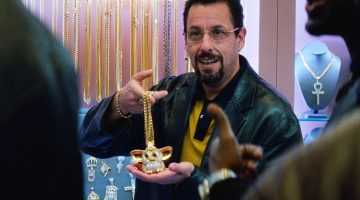YEAR END LAST MOVIE STANDING
As much as In Memoriam segments remind us often stunningly which celebrities died over the past year, they might also suggest that surely we – the non celebrity – can meet our unexpected demise. Any of us. At any time. In a myriad of ways. Old and nearly forgotten; in our primes; after courageous battles; in anonymous, privately kept agony; young, brazen, and tragically stupid; after making our mark; without the surface of our potential remotely scratched.
And watching the array of here today gone tomorrow faces fade in and out accompanied by melancholy strings and a smattering of respectful applause, we might also come to recognize how dear survival is. That we are fortunate to endure for a day or days despite our mortal default. That we manage to persevere in a world so diabolically creative and mercenary in its chaos.
If 2012 was chaos (see last year’s recap), 2013 is chaos survived.
Damaged, bent, maybe even broken, but alive. Not a face on the billowing screen to be remembered for what was – a closed book, its chapters written and finite – but a living story, with tales untold.
To understand survival in its elemental form, we must begin alone.
Alone.
Far from help or comfort.
To test our will to live.
“All Is Lost,” cries (or, perhaps, whispers) the title of J.C. Chandor’s remarkable sophomore effort. Remarkable because it sails onto the screen without pretense, less context, only one character, and zero dialogue. Of all the films expressly centered on survival over the past twelve months, All Is Lost is uniquely focused on self-reliance, and that says a lot considering the company it keeps. Chandor is intent to depict the slow burn of the human spirit as it smolders from reflective, to instinctual, to defeated, without any sentient support system in place. And his surprising canvas is none other than the weathered face of film legend Robert Redford. Surprising not just because Mr. Redford is long past his matinee idol days and is a rare presence in front of the camera. Not just because he is nearly eighty years old and has no business climbing masts and being thrown from starboard deck into the tumbling sea. The choice is most surprising because Redford has never been one to portray the everyman. And certainly not the everyman failing. The everyman losing hope. Redford is supposed to forever be bigger than life. An imposing figure in calm, cool, collected control. And yet Chandor (and Redford) make it work. Not just despite Redford’s facade and symbolism, but because of it.
As we will see reading on, survival – like all subject matters – is most cinematic on an epic scale. When man (or woman) outlasts the hot pursuit of DEATH! When our hero steps from the ashes, leaps from fiery wreckage, climbs exhausted from the midnight dark pit. Survival is best served loud and brash, clanging, roaring, and popping with debris and sparks and rubble. These ingredients add to an appreciation for the amazing miracle that is our continued existence. But All Is Lost is not trying to impress upon us a death defying spectacle or even looking to make anyone sweat. This is devastation in its real world format. Gradual, frustrating, unintentionally brutal, unconsciously evil. Our man is being picked apart and worn down with every grumbling storm cloud in the distance, every gurgling leak, every desperate S.O.S that goes unheeded. One can only be rescued and remain afloat so many times before succumbing to hopelessness. And there is no more hopeless a phrase in the English lexicon than Chandor’s film’s title. No bleaker a situation than the one into which our protagonist devolves. This is where the choice of Redford makes its most lasting impact. Because we are sure he will survive. His intelligence and ruggedness demands that he find yet another way to overcome nature’s cruel betrayal. But as the film goes on, we see Redford in a new light. A light dimmer and paler and murkier. Once a golden god on screen, there now remains a hobbled everyman. Because when all is lost, all is all encompassing. It steals not just our final breath, but our beauty and dignity as well.
The chance of a film like All Is Lost being produced in general is remote. The chance of it being produced and released within months of its cosmic twin sister is infinitesimal. Thematically, the two are nearly identical, but while Chandor’s work keeps the material grounded (granted, in the water), Alfonso Cuaron’s Gravity is a space odyssey that defies definition.
Just as space is unfathomable, so too is firm comprehension of Cuaron’s intention. The metaphor of his film is so finely adhered to the phenomenal three dimensional experience, that processing its depth and profundity dances on the outer rim of critical imagination. While it may be bad form to write from a position of perplexity, Gravity does not lend itself to adequate description. It dictates how and where it should be seen – tremendous screen, 3D glasses, in blistering surround sound. Beyond that, we wonder: Is it high concept art? A star spangled rollercoaster? A summer popcorn blockbuster? Tough to figure, but provided that we have followed the viewing mandates, let us begin then in orbit, where we are finally no longer alone. We have two mates and guidance from base. But, it is still orbit, where man floats and exists by the grace of sensitive technology. Where, unlike the formidable ocean, organic life is not even meant to be. Where the barrier between a clean inhale and strangling death is a pressurized chamber, an oxygen tank, the capacity of one’s lungs – all ripe for malfunction and disaster.
In this fearsome atmosphere do we find American astronauts, Ryan Stone, Matt Kowalski, and the faceless Shariff. With this, we leap from the solitude and anonymity of All Is Lost to a dimension with some stability, familiarity, and dare we say comfort. Yet, it still does not feel right. All may not be lost, but impending pandemonium is tangible. And if Gravity is the midsummer nightmare’s dream that many contend it to be, then Ryan Stone is played by a dreamlike version of Sandra Bullock. The spunky girl from Speed – the comedically awkward woman from Miss Congeniality – the feisty mother from The Blind Side – Ms. Bullock is a now a diving, scurrying, back-flipping angel; ethereal in her frenetic cling to life and home. And if angels can have angels, her’s is George Clooney’s Kowalski; all charm and charisma and calm. The Robert Redford of his generation. Almost oblivious to the possibility that all can ever be lost. A man above ever being reduced to an In Memoriam segment. Perhaps so far above that he is metaphysically aware (omniscient) that we are bundled in Cuaron’s pre-fabricated, artificial trap.
When the inevitable strikes with a blaze of hurtling, acrobatic, ear-splitting chaos, we are left to navigate the cosmos with an unprepared for the moment Stone. She now too is alone and follows that same hope to defeat arc, but there are glimmers of light at the end of her tunnel, and all may not be lost. Or is Cuaron playing tricks within tricks? And we are anxious to hold on to her – to protect her – because although we know quite well that none of what we witness is real…what if this is not a dream? What if we are not nestled in a metaphor? What if Stone planting her feet once again on terra firma is important? What if she must survive?
Cuaron choreographs ingenious, if not unbelievable sequences of near tragedy, and prompts us to care even more due to a rather strained storyline about remorse and redemption, but make no mistake – Gravity is entirely about the sensual. A marvel of performance and effect utilizing the man against his environment/survival motif to justify visual and technical elegance and brilliance.
And as we have just contrasted survival in its realistic and fantastic renderings, let us venture the subject in its actual, biographical form.
In a film sure to capture numerous awards, we learn the true story of a man kidnapped and sold into slavery. The year is 1841. Solomon Northup is a free black man of position living in upstate New York with a young family. He is then duped, kidnapped, and transformed into a slave. Somehow, 12 Years A Slave is more specifically about survival than our prior specimens. It introduces the concept most vital and common to everyday survival – that would be endurance. While All Is Lost and Gravity ask their respective survivalists to beat the odds and bear the crucible for a number of days and a number of hours, Northup is wallowing in a prolonged misery.
An argument can be made that our will to live is never tested unless it is tested continuously and relentlessly over an extended period. And isn’t slavery mainly about the white slave owner administering generational psychological treachery upon his fellow man? Convincing him through consistent despicable behavior that he or she is lesser and properly subservient. That to surrender to a dismal, inhuman fate in docile fashion would be for the best. That you are not YOU, and yours are not YOURS, but all is property, no more valuable or worthy of consideration than a mule or a boot. So Northup must endure torture and degradation, and worse off for once tasting freedom and harboring hope that a savior will come. And do not underestimate this element of the narrative. What increases Northup’s horror also serves as the secret to his survival. Steve (Shame) McQueen’s film (written by John Ridley, based on the memoirs of Northup) provocatively contrasts Northup’s circumstance to the slaves bleeding, murdered, being raped, and abused around him. It is his hope (and, yes, of course, intelligence and savvy) that allows him to sustain inhuman treatment. That allows him to tread in blood and keep his toes tapping the mud beneath his feet while dangling from a noose.
12 Years A Slave has brought inhumanity into our discussion. While Nature/Fate/God can perform apparent wickedness without conscience as displayed by our first two films, neither hold a candle to man. Man who will excuse and take false pride in his malice. Man who is capable of mercy, but chooses heartlessness. Man who will sink into a stubborn state of denial and hate, and spread the disease to insulate and rationalize his sin. Northup is not raging against a soulless storm at se

Gravity
hing glorious about it. It happened as it happened. Even with some selective, perhaps disrespectful dramatizations, this is ugly any way you slice it. The sheer irredeemable gruesomeness makes learning something from the tragedy of the failed mission difficult.
We are made to understand that Navy Seals are the best of the best of the best, trained to withstand extreme conditions, follow orders, and stand by each other with the fiercest loyalty. We are made to understand that they are willing to die for their brothers and country. And taking these superhuman attributes for granted, we understand that Navy Seals are also regular guys who need to keep their girlfriends happy by choosing a palette for the dining room.
Similar to Northup, Lattrell survives the film only because he did in life. History dictated the outcome of Berg’s direction, however improbable as the action unfolds. Lattrell was rescued and resuscitated and wrote his book and wishes to honor his fallen teammates by having us remember them via Hollywood fireworks (but more about leaving a legacy later). Unlike in all our previous cases where mind over matter was relied upon to persevere, Lattrell survived by what amounts to dumb luck and human kindness. He is shot in the right spot. Breaks the right bone. There is as much a target on his back as any other American behind enemy lines. Yet he survives and his brothers are torn apart by bullets or incinerated.
The rather tedious final third of the film would have us believe that Lattrell makes it out due to some inexplicable Muslim sacrifice and impeccable, only in the movies timing, but that is irrelevant. Because whatever happened, whatever it took, the man did in fact survive. When all was lost – in our lifetime (less than ten years ago), across the globe, in a war we are still fighting – he found a way to come back from the brink.
And speaking of war and brinks, we can segue quite effortlessly toward the teeming landscape of World War Zwhere a virus is spreading like nothing we’ve seen since the last zombiepocalypse movie. Although it felt for a while like one could not travel four paces without bumping into a walking dead production, Marc (Montser’s Ball) Forster presents the phenomenon’s first “serious” big budget treatment (with reverence to 2007’s Will Smith vehicle I Am Legend). And it amounts to much of what we’ve seen before, but with more exotic locations (including an extended Holy Land detour), a superstar centerpiece (Brad Pitt), and state of the art zombie effects (this version of the cretins has them loping in rapid strides and leaping headlong at their prey). Beyond the star power and pretensions of an A-list director,World War Z does not offer any more thrills and chills for the buck. Danny Boyle (28 Days Later) and Edgar Wright (Shaun of the Dead) did so much more with less nearly a decade ago. That is not to say World War Z turned out as weak as it was rumored to be when expenses and rewrites became media fodder. There are plenty of narrow escapes and even more non-escapes, as flesh eating and zombie converting seizes the day (though you never see kid zombies in these movies when one would think they’d be all over the place). We eventually wind up in Wales (why not?) where Pitt’s Gerry Lane, UN something or other (retired, but the only man for the job!), figures it all out and starts working on the remedy. Once the mystery is solved, all the globe hopping immediately becomes extraneous since the revelation was based on information that could have been obtained anywhere. In fact, it is incredible that many, many others did not come to the same conclusion long before Lane puts the pieces together. One trip to any hospital in the world would have born out the same conclusion. But then there would be no movie. No opportunity for Forster and Pitt to “raise” the genre.
So, what does World War Z teach us about survival that the prior films did not? Actually, not a thing. Lane is both good and lucky. He is not immune, nor particularly observant, nor sophisticated. He’s basically a dad with some connections and a willingness to travel and ask questions. He saves the day by figuring out how mother nature hid her weakness, but that is only because the script gives him that distinction. The cleverest, most interesting and courageous man on screen is the scientist who choppered in to South Korea with Lane to find the source of the virus. Upon landing, he is spooked, slips, and accidentally shoots himself in the head. Game over. A few scenes later, the greatest, stealthiest warrior on screen puts a gun to his temple because the zombies are on top of him. Why? A cell phone went off when it shouldn’t have. In a film where such things occur, the only thing we can learn about survival is sometimes you just can’t win.
A no-win situation is what Ron Woodroof finds himself in when diagnosed with HIV in the sad caper Dallas Buyer’s Club.
What is most intriguing about Ron for our chosen perspective is that his situation is most dire and defined, it is arguably of his own making, and yet it appears that determination and optimism alone keep him going. We have viewed subjects with so much survival training and so much to live for, yet none of them exhibit the pure will to live, the fuck you to death and despondency, that Ron Woodroof exhibits with every confident breath and arrogant stare. In a way, he is too ignorant to know he is supposed to wither and die. He refuses to accept medical opinion, and in doing so makes a compelling argument for the healing powers of psychological positivism. Ron Woodroof, with his trailer park, indecent, boozing and binging, no loving family life, is as mentally tough as a Navy Seal. Nothing to live for? Maybe according to you. And damned if Woodroof’s belief in his own immortality didn’t trick the reaper for a spell.
If we had to inelegantly transition from World War Z (once again) to Jean-Marc Vallée’s film, we’d note that, technically, they are both about fending off the death grip of a lethal virus that science has not caught up with yet. While the zombie virus has no cure (other than the tried and true shot gun blast to the brain) and is a fictional malady, HIV and AIDS are real and wreaked havoc in our society (and certainly in the third world) for a terrifying era beginning in the second half of the 20th century. Dallas Buyer’s Club takes place in 1985 when AIDS was the plague killing homosexuals and drug addicts, and to be infected with the disease was a death sentence. As such, Ron not only contends with a virus that ravages his body, but he must do so with the world turning its collective back on him.
Besides our being impressed with Ron and retroactively sympathetic to those who contracted HIV and AIDS back when people were petrified assholes about it, the film has nowhere to go once establishing the basic premise of Ron’s refusal to fade quietly into the night. Sure, the virulent homophobe develops a captivating, however desperate, bond with a transvestite (played with mind-bending authenticity by Supporting Actor Oscar contender Jared Leto). Sure, he starts a business providing experimental drugs to “help” his fellow sufferers. Sure, he keeps on living and “fighting.” Fighting the evil, greedy pharmaceutical companies. Fighting the statistics that say he should be in a box six feet under. And, far less impressively, fighting his own prejudices as he finds himself on the other end of the ridicule stick. The problem is that while Ron may not run out of steam, the film about him does. Vallée loads the second half with repetitive themes and amateurish contrivances. When Ron succumbs (in a printed epilogue) and the final credits roll, both are an act of mercy.
Nebraskaallows us to take a sharp turn on this long and winding (and long winded!) road. We have graduated from the literal definition of survival to a more nuanced one. We know already survival means ducking death (whether by chance, skill, or endurance), but only a fraction of humanity is ever challenged by imminent existential threats. From here on out, survival is about what we hope to leave behind. That is, to discover the value of survival. Yes, the age old question, but brought into our construction: What’s it all for?
The term most closely representative of the correlation between survival and life purpose is… legacy. As such, legacy can be viewed as an addendum to survival or the measure of it. Meaning, do we survive each day so that we can reach our potentials and maybe leave a legacy? Or, is legacy an extension of our lives? Is survival a two tier project? First, we survive the various trials of life, including not dying before “our time.” Then we seek to survive our own deaths by leaving something to remember us by.
The ways we attempt to accomplish the latter are three: Our children, our deeds, and our art. While children might be the number one answer on the board, it remains a complicated and unreliable one. We can do our best, but we can never guarantee our children will be representative of us in any substantive way. Children very well may emulate and/or give credit for their accomplishments to parents, but, they very well may not. In truth, our children are independent beings seeking to leave their own legacies, not be ours. Surviving one’s death cannot be as simplistic as parenting a child. We are left then with deed and art.
Alex (Sideways, The Descendants) Payne isn’t known for message movies, although he continually makes them. His talent (or brilliance) is in conveying transcendent messages about life and human nature in mainly sour, satirical packages. Until now, he has utilized a vibrant camera and Hollywood royalty to deliver said parcels. Nebraska is an about-face, and, although it is an improvement over the indulgent Descendants, it does not resonate as resoundingly as his earlier work. It is filmed in black and white (for no apparent reason) and its stars are Bruce Dern and Will Forte. The plot is certainly Payne’s most minimalist (from Bob Nelson’s screenplay – the first movie Payne directed without at least co-writing). Father and son travel some miles for some trivial reason and wind up learning about each other. There are no emotional breakthroughs or heartfelt confessions of the melodramatic, swelling score variety. This is Alex Payne. We get quirk. We get dark humor. We get honesty. We get a memorable Bruce Dern as a forgetful Woody Grant. Dern, getting the afterglow spotlight after a long and distinguished career in supporting roles. Woody, so stubborn. Fighting tooth and nail to leave something meaningful for the kids. Yes, he’s an old timer. He has survived. He has left children to carry on the Grant name. But, his wisdom is down home, and he knows that alone is not a legacy. Nebraska and the second tier of survival are about much more.
And if stubbornness is our measuring stick, we have a curious entrant into the race. A peculiar film by all accounts, Derek (Blue Valentine) Cianfrance’sThe Place Beyond the Pines, casts a hypnotic spell buoyed by the disturbing, vexing behavior of Ryan Gosling’s self-destructive Luke. Luke, who is the film’s fleeting lead and sets into motion the off balance narrative. Cianfrance’s style (from a script he co-wrote) is unsettlingly unpredictable and almost organic. Much like Luke’s aversion to customary standards, the director does not play by the rules of competent filmmaking or seem to follow any safe or determinable road. Characters come and go with points of view jumping, directions drastically changing. We never are allowed to unwind in Cianfrance’s world. He’s like David Lynch on Ritalin.
It adds up to an entirely unique, dreamlike, stomach churning film experience. If it could be boiled down to something sensical, one might say The Place Beyond the Pines is a staggered character study. We start with a daredevil – interestingly enough, someone who risks life and limb intentionally and through luck, skill, and endurance “survives” a predicament of his own reckless making – and we end with the son of a rising star politician (Bradley Cooper) and the boy he torments at school. The connection between the daredevil, the politician, the bully, and the bullied is the stuff this waking nightmare is made of. The astonishment that Cianfrance pulls off, while testing our commitment to his work but never losing it, is that he connects these characters in a way that is both preposterous and palatable within the context of his fluid, mysterious allegory where nothing is meant to fit into place.
The reason why this film connects to our narrative is because directionless Luke is prompted to find direction solely by a desire for legacy. When we meet him, he is without attachments and flying at breakneck speed toward breaking his neck. But he is not unfeeling. When he learns about a child that he unknowingly fathered, it appears to be a revelation. He had mastered day to day survival, yet legacy – that second tier – had never been an option. And so Cianfrance boldly challenges us to witness the pitiful attempts of an empty, dark soul to leave something worthwhile behind. The Place Beyond the Pines is our model of legacy gone terribly wrong.
Our last two films acutely confront the survival/legacy dynamic. Both are firmly entrenched in the land of the productive living. There is no regretful codger like Woody trying to grasp at straws, or masochistic Luke fulfilling his own doomsday prophecy. Moreover, as we have already surveyed the first two general methods of legacy (children and deed), we finally arrive at art.
In what may be the best overall motion picture of the year (in quite a down year for quality cinema), The Coen Brothers unleash a sparkling ode to the New York folk music scene of 1961. How do I love Inside Llewyn Davis, let me count the ways.
The script (written by the brothers), acting, sets, music, and tone are flawless. The authenticity of the atmosphere, mood, singing (all recorded and filmed live) is beyond compare. A miraculous legacy of art, Joel and Ethan Coen have left us.
With my fawning completed, let us move on to the remarkable Llewyn Davis, embodied by heretofore unknown Oscar Isaac. Although this is not his first appearance on screen, for all intents and purposes, let us consider him newly discovered. What the Coen’s pull off in casting Mr. Isaac is what so few studios or filmmakers would ever risk doing – that is have faith in an untested unknown. We can understand why from a marketing perspective, however, Llewyn Davis proves the dividends of such leaps can be enormous. What better way to have an audience unreservedly believe in a character. For all we know, Mr. Isaac is Mr. Davis. Of course he is not, but for all we know he is. And therefore we don’t just watch him wrench his guts to find satisfaction in relationships and in the sorrowful music he plays. We ache with him. We walks through the snow and chase cats with him. We despise him. Contrast this to our feelings for a friend of Llewyn played by Justin Timberlake. Even while supplying a fine and joyful performance, we cannot but mentally shout, “Hey! That’s JT!” But Llewyn is unrefined, unadulterated, pure folk hero forevermore.
What makes the film serve our legacy thesis is Llewyn’s cold, painful to behold unwillingness to change. It applies to his faults, and, most significantly, his art. His art defines him. He may very well know that a loving family is not in the cards. He is likely aware that his irredeemably prickly demeanor will keep him alone and prevent a legacy of deed. But he has bottomless wells of sweet, soulful music inside of him. He has a guitar and fingers to pick and strum its strings and make the angel’s cry. He has a voice that soars in its sullen, nasally magnificence. He knows he can leave behind his art.
Llewyn Davis, entertaining and witty as all Coen productions quite naturally are, teaches us about the devotion one must have to their art if they intend it to survive them. At the same time, it questions whether we are required to make concessions, to be flexible, to “sell out” in order to assure that there is a legacy to speak of. Essentially: Is genuine art that dies with us superior a legacy to a more crowd pleasing version that lives on.
That really is the matter at the center of the film we will discuss and conclude with, John Lee Hancock’sSaving Mr. Banks. To do so we must enter a meta-realm where we have Walt Disney Studios producing a film about Walt Disney. Where the film is technically a 2013 art legacy about Walt Disney’s venture to leave an art legacy (1964’s Mary Poppins) while the author of the 1934 book series upon which that film was based, P.L. Travers, frets about the corruption of her own art legacy.
We began by comparing two sister films in All is Lost and Gravity, noting their incredible thematic similarities. Much the same can be said about Davis and Banks, ironically both set in 1961, on opposite sides of the country and on opposite ends of the commercial spectrum.
While Banks gives us the guilty pleasure insider tour of Mr. Walt Disney’s world (the man played charismatically by Tom Hanks, but it’s that JT affect all over again), the film is about Travers and her unwillingness to compromise when Disney comes a knocking to convert her books into the classic Julie Andrews musical.
Hancock, from a Kelly Marcel and Sue Smith script, includes haunting, golden hued background via intermittent flashbacks as to why Travers (a very game and welcome return to Emma Thompson) holds on to her material so stubbornly (there is that word again). But daddy issues aside, we find ourselves wondering back on Llewyn and his reluctance to modify his vision. To surrender any ground in the name of making others happy, even if it may ultimately bring him solace and success. Travers rages against the corporate system in the same way.
She actively abhors the Disney spirit in all its indelicate, anti-English gregariousness. She aggressively resists the temptation to become seduced by the Disney machine, its cheer, “sincerity,” and toe tapping tunes. Watching the film and thereby becoming susceptible to its shameless heart tugging, we are equally at risk without conscious resistance. Again, the question: Should Llewyn change? Should Travers? Should we?
The film’s failiure to become true, serious, genuine art falls on Disney the studio (circa 2013) in the tradition of Disney the man (circa 1961). This is a film aiming to please (and manipulate) and so it panders and cannot resist treacly sentiment. It urges us to be moved and believe, but only to a comfortable degree. It does not mind raw emotion as long as it is delivered beneath a shimmery smooth veneer. Any and all medicines are accompanied by spoonfuls of sugar. And therefore the art legacy is undeniably compromised. But in the end, it is Disney, genius purveyor of what the people want, international symbol of selling out, who will survive us all.
Jordan Hiller can be reached: Jtrick1@aol.com











